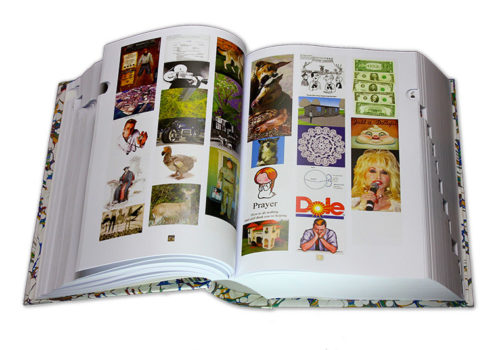Felix Heyes and Benjamin West, of the collective King Zog’s, came up with the idea to manually collect the first results in Google Image Search for the 21,110 words of the Oxford English Pocket dictionary, as their final project for Saint Martins, the prestigious London art school. Then they turned it into a book. Oh, what long, absurd, sleepless nights they must have spent. And yet…
This month the publisher Jean Boîte will release 1000 prototype copies of this visual dictionary, Google Volume One. The editors David Desrimais and Mathieu Cénac created software that simultaneously collected the first occurrences of each word in Google Image Search, producing an inventory of Google’s visual representation of words at a single time. Search results on Google change constantly, and the second volume will simply be this one’s twin brother. (This edition differs from the prototype produced by the two students two years ago.)
This 1,328-page doorstop is more than a mindless accumulation of unrelated images, and more than a visual marathon for insomniac geeks. Rather, it’s an exploration of the themes intrinsic to digital transformation.
On the one hand, the appropriation of web content re-assimilated into a work of art has become commonplace. Two years ago at the Rencontres d’Arles, in the exhibition From Here On, Clément Chérox, Erik Kessels, Joan Fontcuberta, Joachim Schmidt and Martin Parr—curators 2.0—presented a set of photographs made from raw web imagery. “Nothing is lost, nothing is created, everything is transformed.” That could be the motto of this collection of visual art, which applies an environmentalist philosophy to recycling images into the creation of new things. (Also in this exhibition were Jon Rafman’s unusual images taken from Google Street View, and Marco Bohr’s hilarious compilation of Kim Jong Il photos. Both artists are published by Jean Boîte.)
On the other hand, this glut of ultra-accessible images has desecrated our relationship to images. Browsing the book and it’s 20,000 images stuck one on top of the other gives the proliferation of images a natural feel. It almost stings your eyes.
The images fly by without any additional information , which shows how our values have been leveled by the internet. There’s no longer a difference between an artwork, an instruction diagram or a product sold online. They’re all the same in the free-for-all of Google Images. On the same page of the dictionary we find Dolly Parton looking a bit bloated, a few green bills, and a doctor. “Poor Mona Lisa, she’s right next to a picture of a skin disease,” writes David Desrimais. Hanging alone on her wall at the Louvre, the Internet hasn’t done her any favors.. Times have changed, Mona.
http://kingzog.com
http://www.jean-boite.fr
















